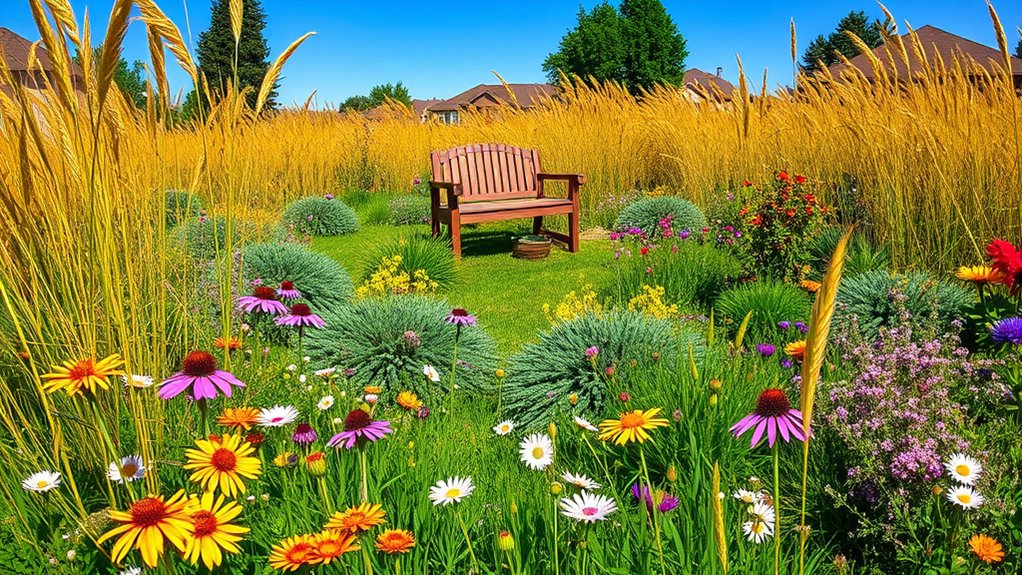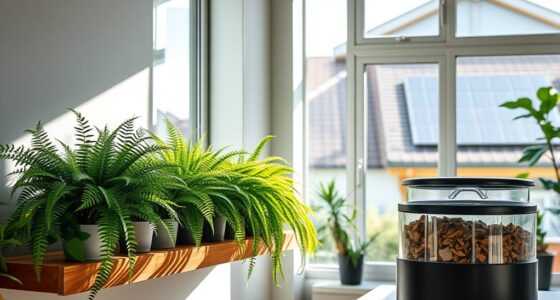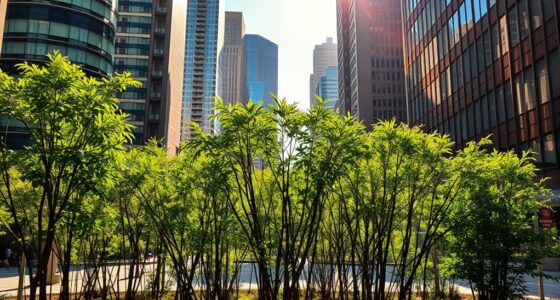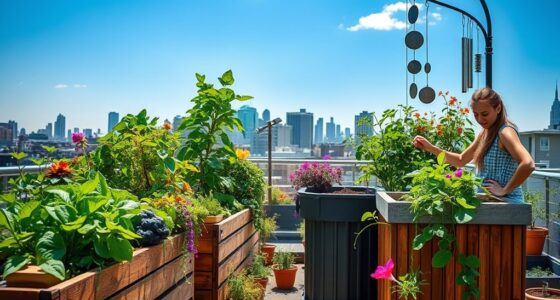Rewilding your suburb by transforming traditional lawns into native meadows benefits your environment, neighborhood, and personal well-being. You’ll promote biodiversity, attract pollinators, and reduce urban heat by choosing suited native plants. Preparing your soil, designing a natural layout, and maintaining the meadow create a resilient, beautiful space. Small changes make a big impact, and exploring further will reveal how you can successfully rewild your own yard and inspire others around you.
Key Takeaways
- Replacing traditional lawns with native meadows enhances biodiversity and creates resilient, habitat-rich suburban landscapes.
- Proper soil preparation and native seed selection are essential for successful meadow establishment.
- Designing natural layouts and pathways fosters aesthetic appeal and minimizes maintenance efforts.
- Rewilding reduces urban heat, conserves water, and supports local pollinators and wildlife.
- Community involvement and sharing success stories encourage broader adoption of native meadow practices.
Benefits of Native Meadows in Urban Settings

Have you ever considered how native meadows can transform urban spaces? They markedly reduce urban heat by providing natural cooling through dense plant cover, helping lower local temperatures. This not only makes your neighborhood more comfortable but also decreases the need for air conditioning, saving energy. Native meadows excel at water conservation because they are adapted to local rainfall and soil conditions, requiring less irrigation than traditional lawns. This means you use less water and contribute to conserving this precious resource. Additionally, native meadows support local biodiversity, attracting pollinators and beneficial insects. By replacing conventional lawns with native meadows, you create a resilient, eco-friendly landscape that benefits both the environment and your community. Sustainable landscaping practices can further enhance these benefits and promote long-term ecological health.
Selecting Suitable Native Plants for Your Area
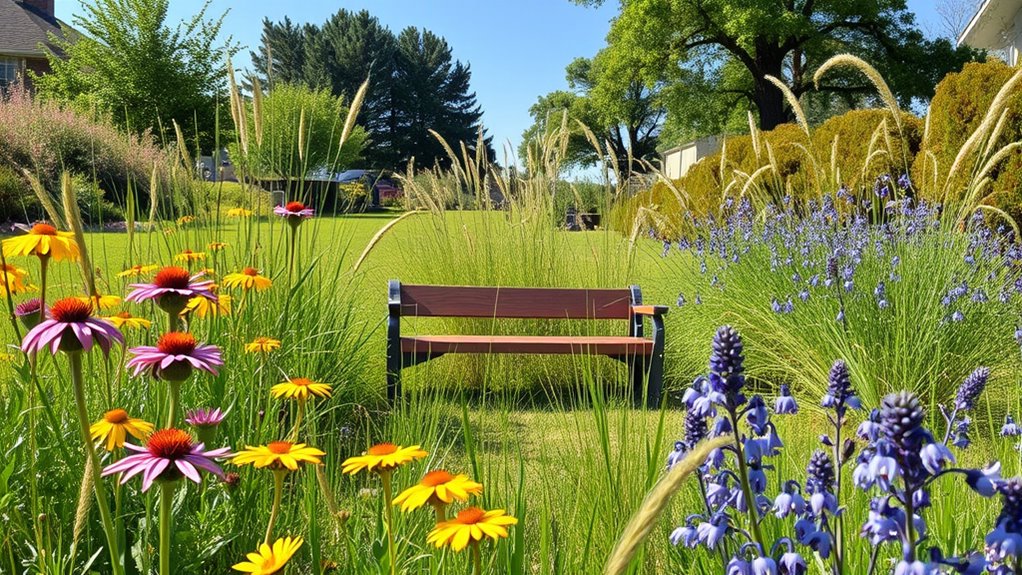
Choosing the right native plants for your area is essential to creating a thriving and sustainable meadow. Start by researching plants suited to your local climate and soil conditions, which guarantees they’ll thrive naturally. When selecting plants, consider your garden aesthetics—opt for species that blend well with your landscape style while supporting local wildlife. Visit local plant nursery selection centers to find healthy, well-adapted native species. Ask staff about the best options for your specific region and soil type. Avoid non-native or invasive plants that could disrupt the ecosystem. Focus on a diverse mix of grasses, wildflowers, and shrubs to promote resilience and provide habitat. Incorporating plants with a high contrast ratio can also enhance visual interest and vibrancy in your meadow. Proper plant choice lays the foundation for a vibrant, low-maintenance meadow that benefits both your yard and the environment.
Planning and Designing Your Meadow Space
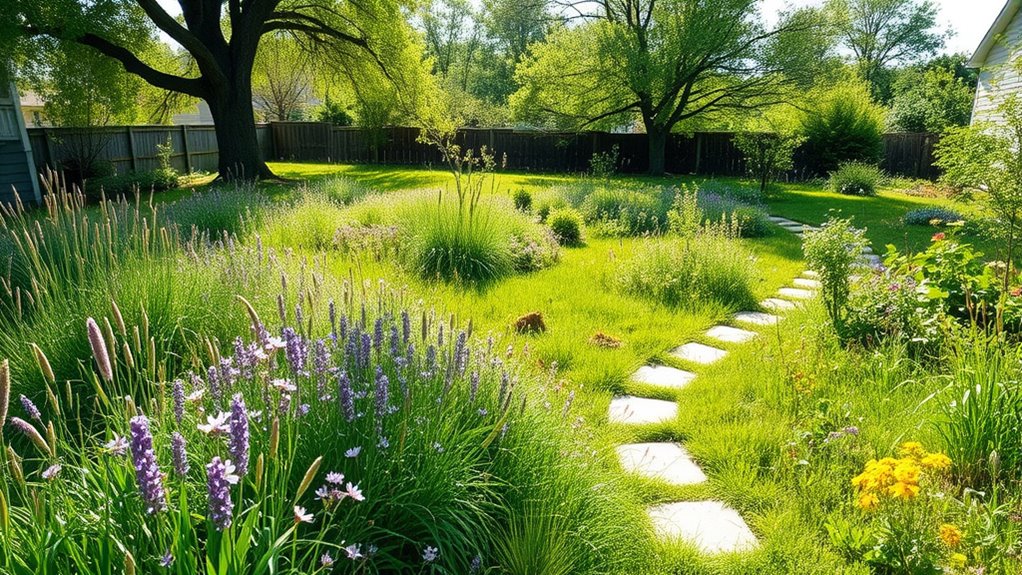
Start by choosing native plants that thrive in your local climate, ensuring your meadow supports local wildlife. Then, plan your layout to create natural flow and inviting spaces, adding pathways and features that enhance accessibility and interest. Keep your design flexible so you can easily adapt and expand your meadow as it matures. Additionally, consider cost and budgeting factors to ensure your project remains financially feasible throughout its development.
Selecting Native Plants
Selecting native plants is a crucial step in designing a thriving meadow that supports local wildlife and requires less maintenance. Choose species that attract pollinators and improve soil health naturally. Native plants are adapted to your area’s climate and soil, making them resilient and easier to care for. Focus on a diverse mix to ensure continuous bloom times and habitat variety. Incorporate plants like wildflowers, grasses, and sedges that provide nectar and pollen. To help you decide, here’s a simple guide:
| Plant Type | Example Species | Benefits |
|---|---|---|
| Wildflowers | Black-eyed Susan | Pollinator attraction |
| Grasses | Little Bluestem | Soil improvement |
| Sedges | Carex spp. | Habitat for insects, birds |
| Perennials | Purple Coneflower | Long-lasting blooms |
| Shrubs | Buttonbush | Wildlife shelter |
Additionally, selecting native plants that are well-suited to your local environment can greatly enhance the success of your meadow project.
Designing Layout and Flow
Once you’ve identified the native plants that will thrive in your meadow, it’s time to plan how they’ll be arranged to create a natural and functional space. Focus on designing a layout that mimics natural growth patterns, ensuring plant groupings enhance garden aesthetics while supporting local wildlife. Think about flow—arranging taller plants toward the back or center, with shorter species in the foreground for visual depth. Consider spacing to reduce lawn maintenance and prevent overcrowding. Curved borders and irregular patches can create a more organic look, blending seamlessly with surrounding landscapes. Keep pathways clear of dense planting areas to facilitate easy access and upkeep. Incorporating vertical storage solutions for tools and supplies can help keep your workspace organized and accessible during planting and maintenance. A well-thought-out plan guarantees your meadow is both beautiful and sustainable, reducing ongoing maintenance while fostering a thriving native ecosystem.
Incorporating Pathways and Features
Incorporating pathways and features into your meadow not only enhances its visual appeal but also improves accessibility and functionality. Well-placed pathways guide visitors through your native landscape, encouraging exploration without damaging plants or disturbing wildlife. Use natural materials like gravel, stepping stones, or wood to blend seamlessly with the meadow’s ecosystem. Adding garden art, such as sculptures or birdbaths, creates focal points and invites wildlife. Keep in mind that pathways can reduce lawn maintenance by defining specific areas, making upkeep easier and more manageable. Features like small benches or log piles can also provide habitat and resting spots for pollinators and birds. Thoughtfully designed pathways and features turn your meadow into a functional, inviting space that supports both aesthetics and ecological health. Incorporating native plants into your design can further support local ecosystems and attract beneficial insects.
Preparing Your Lawn for Rewilding
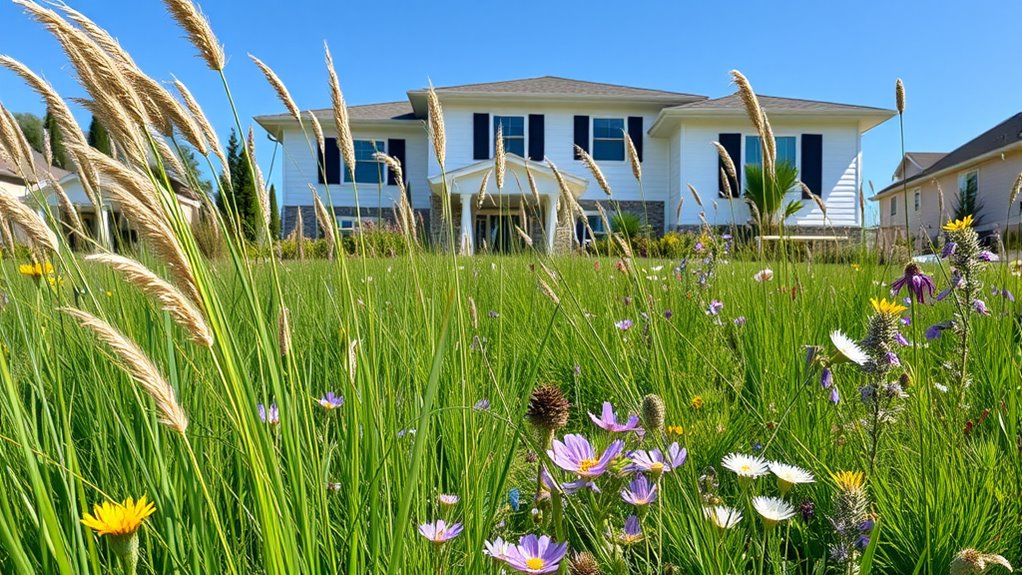
Before you start rewilding your lawn, it’s essential to clear away any debris, weeds, or overly manicured patches that hinder natural growth. Proper soil preparation is crucial for a successful transition; it creates a healthy foundation for native plants to thrive. Begin with lawn removal by stripping away turf and invasive grasses, ensuring you expose the soil beneath. This step reduces competition and prepares the ground for native seeds or plants. Consider loosening the soil and removing any compacted layers to improve aeration and drainage. Avoid using chemicals or pesticides that could harm future soil health. Once the area is cleared and soil is prepared, you’ll set the stage for a flourishing native meadow that attracts pollinators and supports local wildlife. Embracing artistic expression and creativity can also inspire innovative approaches to ecological gardening and native plant arrangements.
Steps to Convert a Lawn Into a Meadow
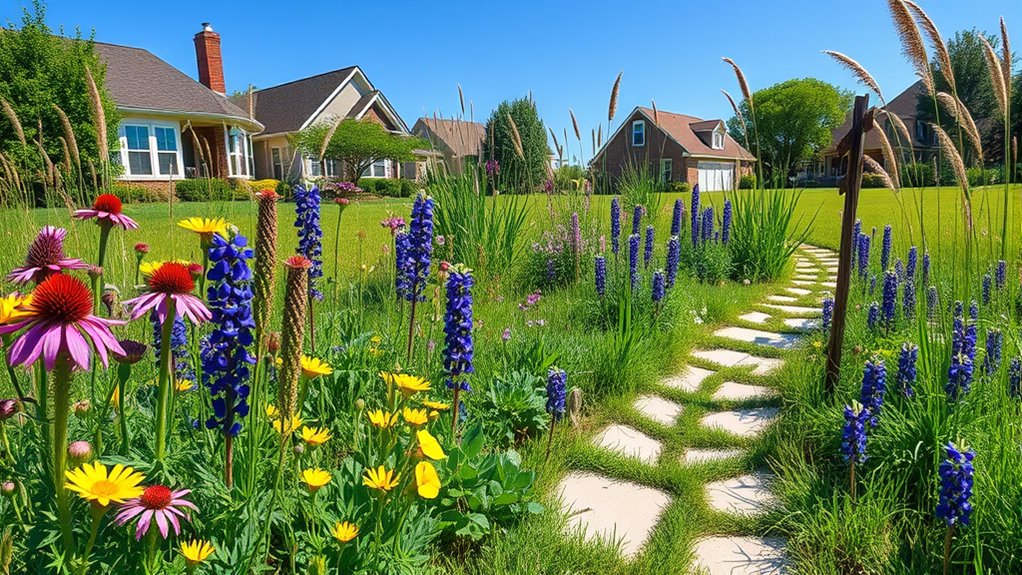
After preparing your soil and clearing away the old turf, it’s time to begin transforming your lawn into a vibrant meadow. Start by testing your soil with a simple soil test kit to determine pH levels and nutrient content. This step helps you understand what amendments are necessary for ideal plant growth. Gather your garden tools, including a rake, shovel, and hoe, to loosen the soil and create a smooth, even surface. Remove any remaining debris or weeds that could compete with your native plants. If needed, add organic compost or soil amendments based on your test results to improve soil health. Once the soil is prepared and nutrient-rich, you can proceed with sowing native meadow seeds, ensuring good seed-to-soil contact for successful germination.
Maintaining and Caring for Your Native Meadow

Maintaining your native meadow requires regular attention to guarantee it thrives and remains a vibrant, ecological space. You’ll need consistent watering routines, especially during dry spells, to keep plants healthy without overwatering. Pest management is vital; monitor for insects or weeds that could threaten native species, and control them naturally when possible. Mulching helps retain soil moisture and suppress weeds, reducing maintenance. Regularly walk through your meadow to spot any signs of distress or invasive plants needing removal. Keep an eye out for overgrown areas that may need thinning to promote biodiversity. Adjust watering as seasons change, ensuring plants get enough moisture without drowning them. Incorporating proper maintenance techniques can further enhance the health and resilience of your native meadow. With dedicated care, your meadow will flourish as a resilient, sustainable habitat.
Inspiring Success Stories of Rewilded Suburban Landscapes
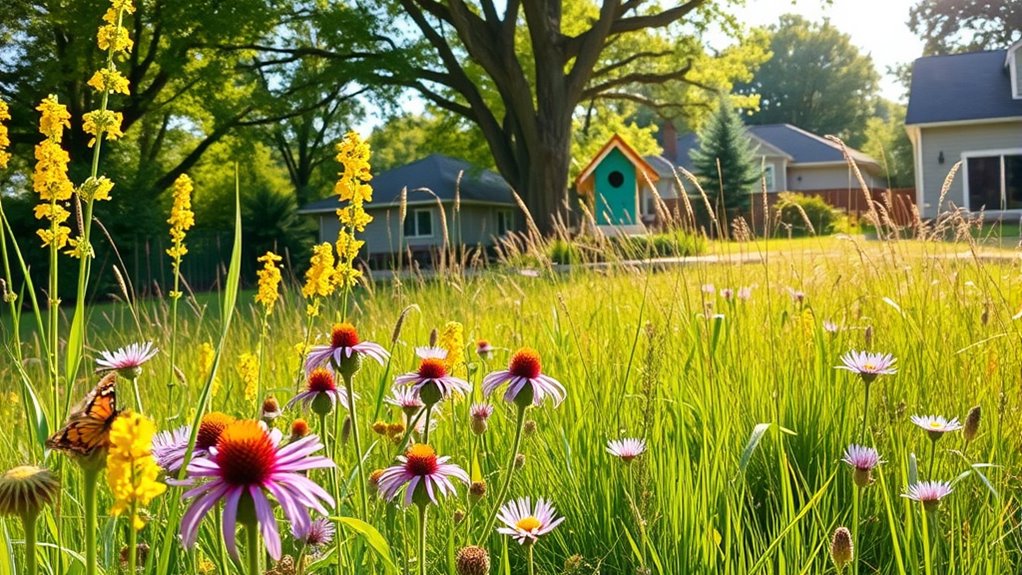
Many neighborhoods have transformed their spaces into thriving habitats, inspiring others to follow suit. You’ll hear stories of native plant revival that bring back local species and create lush, sustainable landscapes. Witness how wildlife is making a comeback in these rewilded areas, proving that suburban spaces can become vibrant ecosystems. Moreover, these initiatives often incorporate native plant preservation practices that support local biodiversity and ecological resilience.
Neighborhood Transformation Tales
When residents in Greenfield decided to rewild their neighborhood, they transformed a once monotonous suburb into a thriving habitat for local wildlife. Their efforts boosted ecological diversity and created a welcoming environment for urban wildlife. You can imagine lush native meadows replacing bare lawns, attracting pollinators and birds alike. The neighborhood now bustles with activity, from humming bees to colorful butterflies, enriching the local ecosystem. Children and adults alike enjoy the newfound connection to nature through community gardens and nature walks. This transformation shows that even small changes can have a big impact. Incorporating native plants enhances the habitat and supports local pollinator populations.
Native Plant Revival
Have you noticed how native plants can transform a dull yard into a vibrant sanctuary? By replacing traditional lawns with native species, you support pollinators like bees and butterflies, creating a thriving ecosystem right at home. Native plants are naturally adapted to your local climate, offering drought resilience that reduces water use and maintenance. These plants flourish with less irrigation, helping conserve resources and cut costs. Their deep roots stabilize soil and improve resilience against droughts, ensuring your landscape stays healthy year-round. Plus, by choosing native plants, you’re fostering biodiversity and creating a resilient, low-maintenance environment. It’s a simple change that makes a big difference—turning an ordinary yard into a vibrant, eco-friendly haven.
Wildlife Comeback Stories
Rewilding your suburban yard can lead to remarkable wildlife recoveries that inspire and energize communities. As native plants flourish, you’ll notice more butterflies, birds, and beneficial insects returning. These success stories often include homeowners discovering urban foraging opportunities, like wild berries or edible herbs, while controlling invasive species that threaten local ecosystems. Your effort creates habitats that support pollinators and small mammals, boosting biodiversity. You might see a family of songbirds nesting in native shrubs or a monarch butterfly laying eggs on milkweed. These transformations prove that even small efforts can restore balance. Sharing these wins encourages neighbors to join in, amplifying the positive impact on local wildlife and fostering a thriving, rewilded neighborhood.
Frequently Asked Questions
How Do Native Meadows Impact Local Biodiversity and Ecosystem Health?
You might wonder how native meadows impact biodiversity and ecosystem health. By supporting pollinators like bees and butterflies, they boost pollinator support, which benefits local plant life. Native meadows also help control invasive species by providing habitat for native plants that outcompete invasives. This creates a balanced ecosystem, improves soil health, and attracts diverse wildlife, making your area more resilient and vibrant.
What Are the Potential Challenges or Drawbacks of Rewilding Suburban Lawns?
You might face challenges like cost management, as rewilding can require initial investments for native plants and maintenance. Community acceptance could also be a hurdle if neighbors prefer traditional lawns or worry about aesthetics. You’ll need to educate residents about ecological benefits and address concerns to gain support. While rewilding offers ecological rewards, balancing costs and community preferences is key to successful implementation.
Can Rewilding Lawns Reduce the Need for Watering and Chemical Treatments?
Rewilding lawns can markedly reduce your water use by promoting drought-tolerant native plants, which need less watering. It also cuts down on chemical treatments because native meadows are more resistant to pests and diseases, reducing your reliance on pesticides and fertilizers. This approach enhances water conservation and chemical reduction, making your yard more sustainable and eco-friendly while requiring less maintenance and cost over time.
How Long Does It Typically Take for a Meadow to Establish Fully?
It usually takes about one to three years for a meadow to establish fully, depending on your seeding techniques and seasonal planning. If you prepare the soil well, choose native species suited to your climate, and seed during ideal seasons, you’ll see faster growth and better establishment. Consistent watering and minimal disturbance also help. Patience is key, as a healthy meadow develops gradually, offering vibrant biodiversity over time.
Are There Legal Regulations or Homeowners’ Association Rules Affecting Rewilding Projects?
Did you know that about 30% of neighborhoods face zoning restrictions that could impact your rewilding plans? You should check local regulations because zoning restrictions and homeowners’ covenants often govern landscaping projects. These rules can limit or specify what you can plant or alter. Before starting, consult your local zoning office or homeowners’ association to verify your native meadow project complies with all regulations and avoids potential conflicts.
Conclusion
By rewilding your lawn into a native meadow, you’re creating a vibrant haven that benefits pollinators and boosts local biodiversity. Think of it as turning a dull, gray patch into a lively, colorful garden teeming with life. With a little planning and effort, you can transform your yard into a thriving ecosystem, making a positive impact on the environment while enjoying a beautiful, natural space right outside your door.
